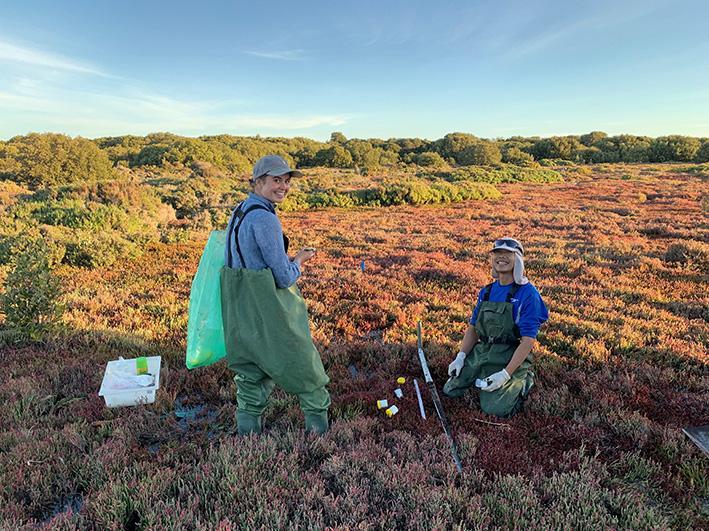New funding for carbon storage in coastal ecosystems

University of Adelaide PhD student Hannah Auricht and technician Tan Dang sampling salt marsh soil cores near St Kilda to analyse for carbon content
University of Adelaide researchers are investigating the potential for more carbon storage in our coastal ecosystems with new funding from the Adelaide and Mount Lofty Ranges Natural Resources Management Board.
The new Blue Carbon Futures Grants projects will investigate blue carbon opportunities across the region. Blue carbon is carbon stored in coastal ecosystems, for example in the plants and/or sediments of saltmarshes, mangroves and seagrass beds.
The funding aims to help mitigate climate change by restoring and protecting Adelaide’s coastal environments, in turn reducing greenhouse gas emissions. If these habitats become degraded or impacted, they can actually increase emissions by releasing greenhouse gases back into the atmosphere.
University of Adelaide researchers are leading or participating in three new projects:
Mapping coastal wetland blue carbon potential in the Adelaide Mount Lofty Ranges (AMLR) Natural Resource Management (NRM) region (lead organisation University of Adelaide). This project will generate a map of Blue Carbon Potential) across the AMLR NRM region, providing an assessment of blue carbon stocks and sequestration rates. It will be the first step towards a state-wide map of blue carbon.
Potential for Zostera seagrass recovery and rehabilitation to enhance blue carbon in South Australia (lead organisation University of Adelaide, with the South Australian Research and Development Institute (SARDI)). The project will assess the extent of carbon accumulation in seagrass meadows, and look at how quickly carbon storage changes with natural recovery. As well as underwater video and dive surveys, drones will be used to map intertidal areas to provide a precise baseline for assessing future changes in eelgrass (Zostera).
A Blue Carbon future through introducing tidal flow to salt ponds and stranded saltmarsh for Dry Creek and the Samphire Coast (led by Flinders University in collaboration with University of Adelaide).This project will assess the Blue Carbon futures for Dry Creek and stranded saltmarsh habitats in Gulf St Vincent. Stranded marshes are those that have been cut off from tidal flows by levees or other developments.
“Blue carbon ecosystems make a significant contribution to the global carbon cycle, with organic carbon sequestration rates and storage periods orders of magnitude higher than in many terrestrial ecosystems,” says Dr Alice Jones, Principal Investigator of the Mapping Coastal Wetland project, and Research Associate in the University of Adelaide’s School of Biological Sciences.
“This makes them of significant interest for national and regional climate change mitigation strategies together with ongoing, high rates of global blue carbon ecosystem loss. Degradation and loss of blue carbon ecosystems decreases the carbon storage capacity of the coastal carbon sink and results in CO2 emissions, while their conservation, restoration and creation have the potential to increase carbon capture and storage, mitigate climate change, support carbon finance opportunities and provide numerous other ecosystem services.”
University of Adelaide researchers involved in the research, all from the School of Biological Sciences, are Dr Alice Jones and Professor Bronwyn Gillanders (Marine Biology); Associate Professor Luke Mosley (Biogeochemisty); Dr Ramesh Raja Segaran (Unmanned Research Aircraft Facility); and Dr Ken Clarke (Spatial Ecology). The projects have received co-funding from the School of Biological Sciences, SA Water, the Environment Protection Authority and the Department for Environment and Water.
